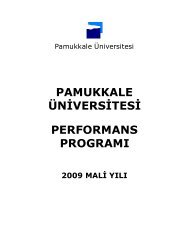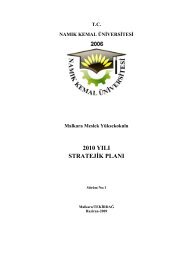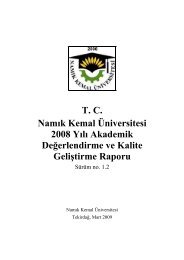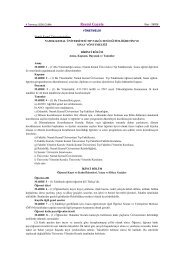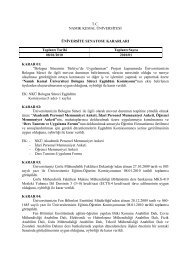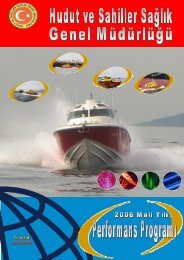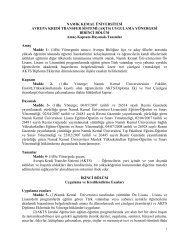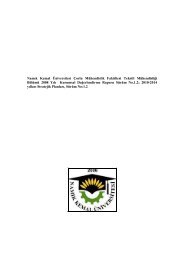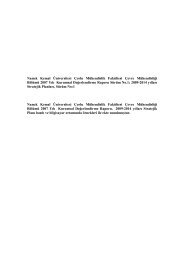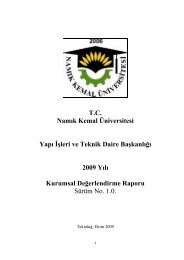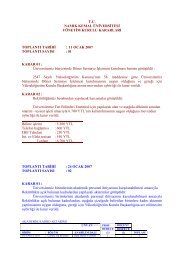PAV and the Cereal yellow dwarf virus-RPV in canary seed (Phalariscanariensis L.). Cereal Research Communications, 36 (2), 225-2347.4.2. Diğer Uluslar Arası Atıf Dizinlerinde Yer Alan Yayın Listesi-7.4.3. Yurtiçi Yayın Listesi-7.4.4. 2007- 2008 Yılında Uluslar Arası Dergilerde Yapılmış Olan BilimselYayın Listesi2008 yılı SCI Yayın ListesiAysal, T. and M. Kıvan, 2008. Development and population growth of Stephanitispyri (F.) (Heteroptera: Tingidae) at five temperatures. Journal of Pest Science81(3): 135-141. (Research Asist. Aysal, T and Prof. Dr. Kıvan M. <strong>Namık</strong> <strong>Kemal</strong> University, Faculty ofAgriculture, Department of Plant Protection, Tekirdag-Turkey) Abstratct: Pear lace bug, Stephanitis pyri (F.)(Heteroptera: Tingidae) is a pest of apple and pear trees and ornamental Rosaceae plants in Mediterraneancountries and palearctic region. The aim of this study is to determine the effects of temperatures on S. pyri inthe laboratory. Development and fecundity of S. pyri reared on apple leaves (Pyrus malus L.) wereinvestigated at five constant temperatures (20, 23, 26, 29 and 32 +/- 1 degrees C) and a 16L:8D photoperiod.Longevity was determined to be 12.6 days at 32 degrees C and 58.7 days at 20 degrees C for females, and9.7 and 37.7 days for males. Females laid 186.9 eggs per female with the highest number achieved during28.5 days of oviposition period at 26 degrees C. Female lifetime fecundity was reduced at 32 degrees C (40.0eggs per female). While the net reproductive rate (R-0) was highest at 26 degrees C, the intrinsic rate ofnatural increase (r(m)) was highest at both 26 and 32 degrees C. The mean generation time (G) wasestimated to be 27.2-78.4 days at 20 and 32 degrees C, respectively. The longest development times for eggand total nymph stages were obtained as 22.0 and 24.9 days, respectively, at 20 degrees C. S. pyri developedfastest from egg to egg in 24.3 days at 32 degrees C. The lower developmental threshold (T-0) was 9.7degrees C and the thermal constant (K) was 517.3 degree-days for S. pyri. Thus, S. pyri is calculated to have3.8 theoretical generations in Tekirdag. The optimum developmental temperature for S. pyri was 26 degreesC.Coşkuntuna A, Özer N., 2008. Biological control of onion basal rot disease usingTrichoderma harzianum and induction of antifungal compounds in onion setfollowing seed treatment. Crop Protection 27: 330-336 (Asist. Prof.Dr. A. Coskuntuna,and Prof.Dr. N. Ozer. <strong>Namık</strong> <strong>Kemal</strong> University, Faculty of Agriculture, Department of Plant Protection,Tekirdağ-Turkey.) Abstract: Trichoderma harzianum KUEN 1585 (commercial product, Sim(R)Derma) wastested to determine its effect on the mycelial growth of Fusarium oxysporum f.sp. cepae (FOC) in dual cultureand its control of basal rot disease in pot- and field-grown onion sets. The abilities of T harzianum to inducethe production of antifungal compounds in sets and to increase onion set diameter were also studied. In potexperiments, where the soil was inoculated with a pathogenic isolate of FOC, seeds were coated with Tharzianum at the dosage of 10 g kg(-1) seed. In field experiments, seeds coated with T harzianum were sownin soil naturally infested with the pathogen. T harzianum inhibited mycelial growth of the pathogen in vitro.Seed treatment with T harzianum decreased disease incidence comparable to the imidazole fungicide,prochloraz in both pot and field experiments. It also enhanced bulb diameter of sets, especially in the potexperiment. Extracts from onion sets grown from treated seeds under both conditions were fractionated bythin-layer chromatography for their antifungal compounds. Most of the fractions obtained from the sets of Tharzianum-treated seeds showed high antifungal activity against the pathogen. This study suggests thepossible role of T harzianum in the induction of antifungal compounds against F. oxysporum f. sp. cepae inonion sets. (C) 2007 Elsevier Ltd. All rights reserved.32
Đlbağı,H., Rabenstein, F., Habekuss, A., Ordon, F., Çıtır, A., Cebeci, O. andBudak, H. 2008. Molecular, serological and aphid transmission studies ofBarley yellow dwarf virus-PAV and Cereal yellow dwarf virus-RPV in CanarySeed (Phalaris canariensis L.). Cereal Research Communications 36: 225-234. (Assoc. Prof.Dr. Đlbağı, H. and Prof.Dr. A. Citir. <strong>Namık</strong> <strong>Kemal</strong> University, Faculty of Agriculture,Department of Plant Protection, Tekirdağ-Turkey.) Abstract: Canary seed (Phalaris canariensis L.) is acereal crop belonging to the tribe Phalarideae of the Poaceae family. A prevailing virus infection, which causesdwarfing of plants and yellowing of leaves, was observed in canary seed fields in the Tekirdag province ofTurkey. The aim of this study was to identify, clone and sequence the cereal viruses naturally occurring on P.canariensis by employing serological tests as DAS-ELISA and TAS-ELISA tests combined with transmissionelectron microcopy (TEM) and molecular analysis. One hundred and one plant samples showing symptomswere collected and tested serologically using polyclonal antisera against Barley yellow dwarf virus-PAV(BYDV-PAV) and Cereal yellow dwarf virus-RPV (CYDV-RPV). The results of both immunoassays showedthat 48% of the samples were infected with BYDV-PAV, 2% with CYDV-RPV and 14% were mixed infection.36% of the samples were uninfected or infected at level below detection. Aphid transmission experimentsrevealed that barley (cv. Rubina) exhibited characteristic of CYDV-RPV. Investigations of infected canarygrass seedlings using transmission electron microscopy (TEM) supported the findings of serological tests andrevealed the presence of isometric particles of approximately 25 nm in diameter. These results were alsoconfirmed by using BYDV-PAV and CYDV-RPV specific primers. Sequence analysis of cDNA and probabletranslation products revealed a high level of homology to BYDV-PAV and CYDV-RPV isolates found in otherplant species. The sequence data obtained from this research were deposited in the EMBL/GenBank DataLibraries under the accession nos. EGO19056 and EF372272.Covelli, L., Kozlakidis, Z., Di Serio, F., Citir, A., Acikgoz, S., Hernandez, C.,Ragozzino, A., Coutts, R. H. A., Flores, R. 2008. Sequences of the smallestdouble-stranded RNAs associated with cherry chlorotic rusty spot andAmasya cherry diseases. Archives of Virology 153 (4): 759-762. (Professor A.Citir. <strong>Namık</strong> <strong>Kemal</strong> University, Faculty of Agriculture, Department of Plant Protection) Abstract: Cherrychlorotic rusty spot (CCRS) and Amasya cherry disease (ACD) are two disorders that affect cherry in Italy andTurkey. Both diseases have similar symptoms and are associated with a complex pattern of double-strandedRNAs (dsRNAs), absent from healthy-looking material. The dsRNAs were presumed to have a viral origin, andtheir characterization showed that: four comprise the genomic components of a member of a new tentativespecies of the genus Chrysovirus, two comprise the genomic components of a member of a new tentativespecies of the genus Partitivirus, and another four display their highest similarity with members of the familyTotiviridae. Because members of these three taxa typically infect fungi, and because microscopy observationshave identified a fungus-like organism in the affected leaf tissues, these data support a fungal etiology forCCRS and ACD diseases. In addition to the ten large dsRNAs, PAGE analysis of CCRS-affected materialrevealed at least another two bands in the lower part of the gels. We presumed that they were generated bysmall dsRNAs, given that the bands were detected in preparations enriched in dsRNAs. Here we report theirsequences.Kıvan, M., 2008. Development rate and lower temperature threshold in the eggs ofEurygaster integriceps (Heteroptera : Scutelleridae), Insect Scıence 15(2):163-166. (Prof.Dr. Kivan, M. <strong>Namık</strong> <strong>Kemal</strong> University, Faculty of Agriculture, Department of PlantProtection. Tekirdag-Turkey) Abstract: The sunn pest, Eurygaster integriceps Put. has a wide distribution inthe Palearctic region. It is the most important pest problem of wheat in Turkey. The objective of this study wasto attain better knowledge of the development of the sunn pest eggs. The lower temperature threshold anddevelopment rate of eggs were determined at 17, 20, 23, 26 and 32 degrees C +/- 1 degrees C in thelaboratory. A linear model was used to describe the developmental rate and temperature. The eggdevelopment required 90.9 degree-days above the theoretical threshold of 11.7 degrees C. The developmenttime was 17.6 +/- 0.1 days at 17 degrees C, and 4.5 +/- 0.01 days at 32 degrees C. Incubation time wasinversely related to temperature. The study showed that the eggs of E. integriceps needed shorter periods oftime to complete their development than immature stages of their parasitoids Trissolcus spp.Mirik, M., Selcuk, F., Aysan, Y., and Sahin, F. 2008. First outbreak of bacterialblack rot on cabbage, broccoli and brussels sprouts caused by Xanthomonascampestris pv campestris in the Mediterranean Region of Turkey. PlantDisease 92 (1): 176. (Diseses Not)33



